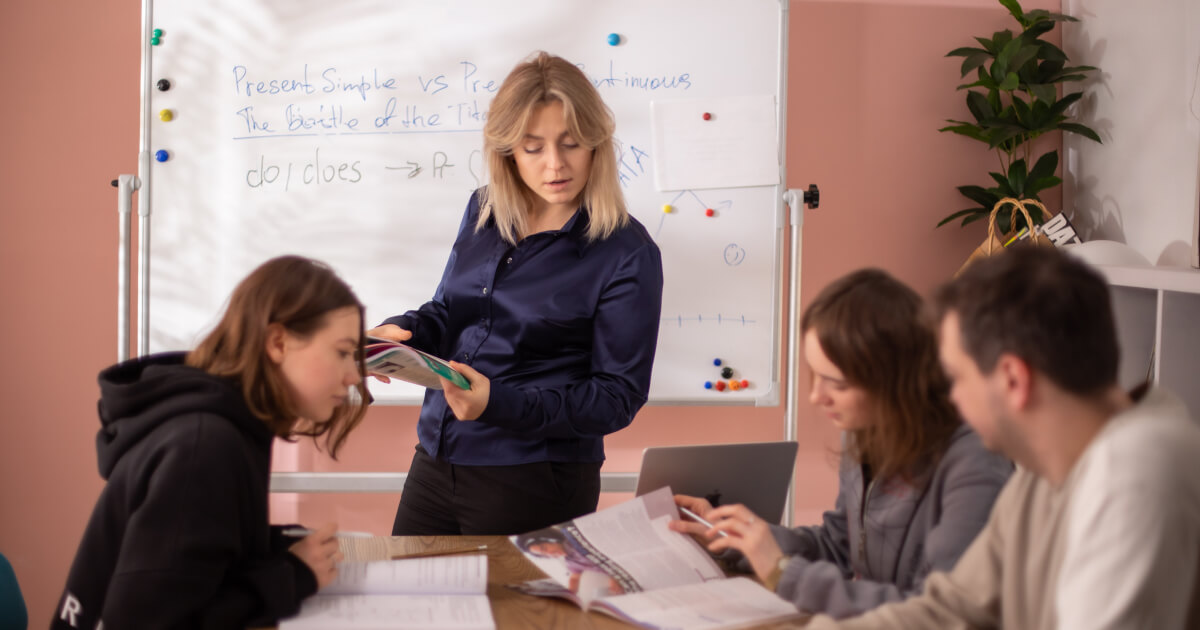Classroom management and student organization during online lessons
- Tips & Strategies
- Methodology

12.12.2024
When it comes to learning any foreign language, it is sometimes challenging to cope with lots of new information. Every teacher sometimes feels desperate and sad when, after a lesson or two, students don’t remember much. What is worse, you have prepared various activities and nice visuals — and nothing. It’s all about memory.
As teachers, we have to play different roles during the learning process. It looks like we should come up with some creative and efficient ideas to help our students boost their memory and expand their language storage, so the knowledge won’t slip away right after the lesson. In this case, we act like teachers with a pinch of a scientist.
Let’s not forget that you still have a lesson to teach, so don’t prepare or focus too much on memorising, but try to make it as concise and efficient as possible.

Learn to teach with TBL
Apply TBL in your classroom as effectively and efficiently as possible with our course.
Why do we need to help our students to hack their memory? Everyone’s memory works differently. This brings us to 4 learning styles and it’s important to be aware of that.
Some students memorize information better by looking at something which is referred to as visual style.
They are most likely enjoying any kind of pictures, graphs, or other visual support you can use. Others find it more effective to listen to something. We know them as aural learners or auditory learning style.
They can recall most of what they have heard.
Maybe you can have students who are very active and use gestures and movements while using some words or phrases. Those are kinaesthetic learners.
Kinesthetic teaching activities for ESL students
And last, but not least. Some people are good at defining and explaining complex concepts using simpler wording. Those are learners with strong reading and writing preferences and their best tool to learn is words.
Of course, it’s impossible to have a whole class of visual or aural learners, but it doesn’t mean you can’t combine various channels of information perception to make it even more effective for everyone you teach.
Before you memorise something, you need to study it. Remembering starts when you present and explain language units to your students. It includes meaning, form, and pronunciation. At this point, you use context, and this is one of the most vital things you can give your students.
Any language device (grammar, vocabulary, or functions) is remembered to be recalled through the wisely chosen context. It’ll create strong connections and help students not only to remember but actively use what they have learned in the classroom.
After you are done with the presentation you need to help students memorize everything.
No teacher has ever used this technique. It can be used to memorize almost everything. Moreover, there is space for creativity. You can always adapt your drills to your students’ needs and learning styles. You can start with the usual “repeat after me” one. But here are some jazzed-up versions of drilling that your students might enjoy.
This one will engage all the students. First, you need to divide your students into two groups (boys and girls, by their names, random numbers, birthdays, and many other groupings — choose what suits you the most).
Then show them how it’ll work:
Each group repeats different lines.
Group A: you read the question "What's this?" twice
Group B: you answer by looking at the picture that the teacher will show you“It’s a dog” twice
Show them the rhythm. There is a noisy modification:
Recite a few times so students learn and remember the rhythm. This can be helpful and fun for younger learners.
Repeat the procedure with all the items. You can switch roles.
Your aural, kinaesthetic and visual students will enjoy this activity.
It’s a good way to remember any kind of language items, including grammar, spelling, vocabulary and functions.
Disappearing pictures: this is a variation that can be fun and effective in memorizing vocabulary.
These types of drills will be suitable for visual and learners with strong reading and writing preferences.
It’s an engaging activity that will help your students not only memorize language but practice listening and pronunciation too. This way everyone can invest in each other’s learning. To make it more meaningful, set the goal to make the longest sentence possible.
Imagine, you’re teaching personality adjectives. Ask your students to associate one word with themselves. Set your own example: “I’m friendly”. Ask the next student to repeat your phrase and add their own. To make it even more challenging you can ask to change previous phrases: “Yulia is friendly, and I’m crazy”.
Don’t forget to help students or ask other students to do so, because in the end, it’ll be a massive word snowball!
What every teacher needs to know to teach vocabulary effectively?
Do you think that the games are only for kids? Hopefully, no. Because everyone can play and it can be beneficial for learning. A little fun never hurts anybody.
This game provides your students with an energy boost and rapid recall. It can be done open class, or ask students to do it in small groups or pairs after you’ve done it together.
The student who holds the bomb which explodes gets an extra task to complete.
STOP, Scattergories: Divide students into groups and provide categories, then call out a letter. Each group has a few minutes to list words in each category beginning with that letter.
Points are given for unique answers, pushing students to think beyond common words.
Also, give it a try and make some families. Group the words based on how they are connected. To organize the items, you can use mind maps, charts or diagrams.
For example, your students are learning about the home. Ask them to make lists of the words related to the topics: rooms, objects, actions etc. Then, ask your students to group the words depending on how they are related.
For example:
As an option, you can ask your students to add new words to the lists every time they discover them.
Often, students can remember the meanings and can understand the context. But there is trouble — s-p-e-l-l-i-n-g.
English is known for the difference between spelling and pronunciation. You can help your students to memorize how the difficult words are spelled by grouping them together based on their similarities.
Let’s say you’re teaching a set of weather words: heatwave, hail, freezing, boiling, heavy rain, snowstorm, blizzard, thunder, lightning.
Ask your students to complete the following groups:
Before you do this, think about the categories you can use.
Another variation uses a different tense form. In this case, we’re integrating grammar and vocabulary. For example, if your students learn verbs and have trouble remembering grammar forms, ask them to choose the words they consider difficult. Then, your students should write the verb using different tenses.
You are teaching free-time activities and present tenses. Students struggle with present simple and present continuous. Ask them to complete the table with the words they chose using present simple, continuous and perfect.
Do yoga
Make cakes
Present simple | Present Continuous | Present Perfect |
She makes cakes every day.She doesn’t make cake every day.Does she make cakes every day? | She’s making cakes now.She isn’t making cakes now.Is she making cakes now? | She’s already made cakes.She hasn’t made cakes yet.Has she made cakes yet? |
The drawback of this technique is that it’s a little time-consuming. But it can be beneficial to keep intact grammar and vocabulary. Try not to ask to complete a large number of words. Focus on the ones that are the most challenging items. If you manage to make it a part of your lesson routine, you’ll see results very soon.
Constant and frequent revision is key for successful learning. It is also an important tool to train and challenge our memory.
Easy. Try to dedicate some time to recalling some words or structures in every lesson. Keep it simple and focus on what’s the hardest for your students: spelling, use in context, or pronunciation. It’s a good idea to implement learned material into new topics. Constant revision is a powerful tool.
Try to revise language as often as possible. Implement them into grammar practice.
For example, you can start the lesson with a pop quiz or some discussion questions where students can use the target language.

How to teach English to Gen Z?
This generation values creative freedom and self-expression!
There is so much more you can do to help your students memorize. Test some of these and create your own variations. Remember, it’s really important to put your students’ needs first — and you’ll know how to help them.
Yulia Popyk
Author
Teacher of General English & Young Learners, Exam Prep
Comments
Leave your comment